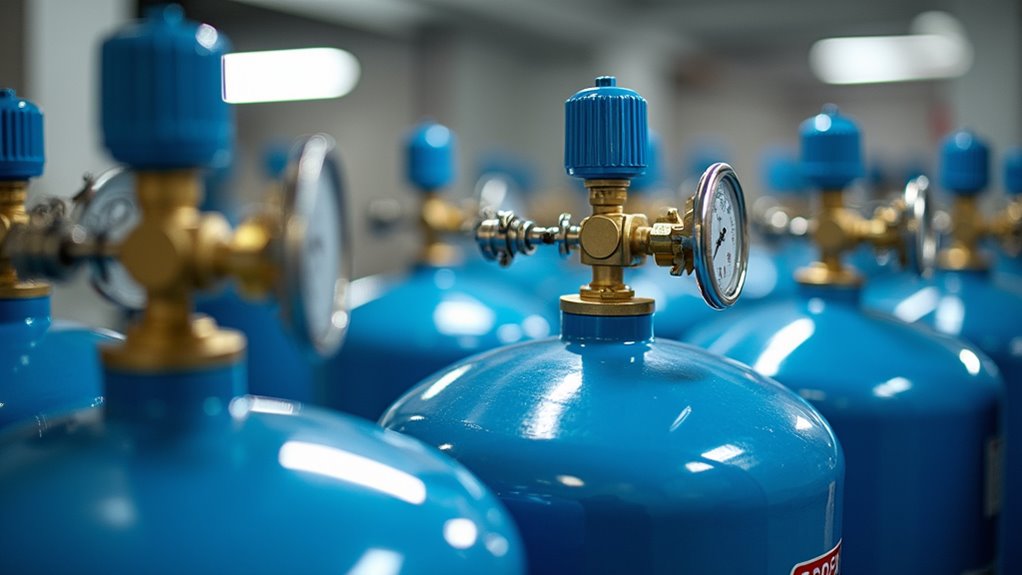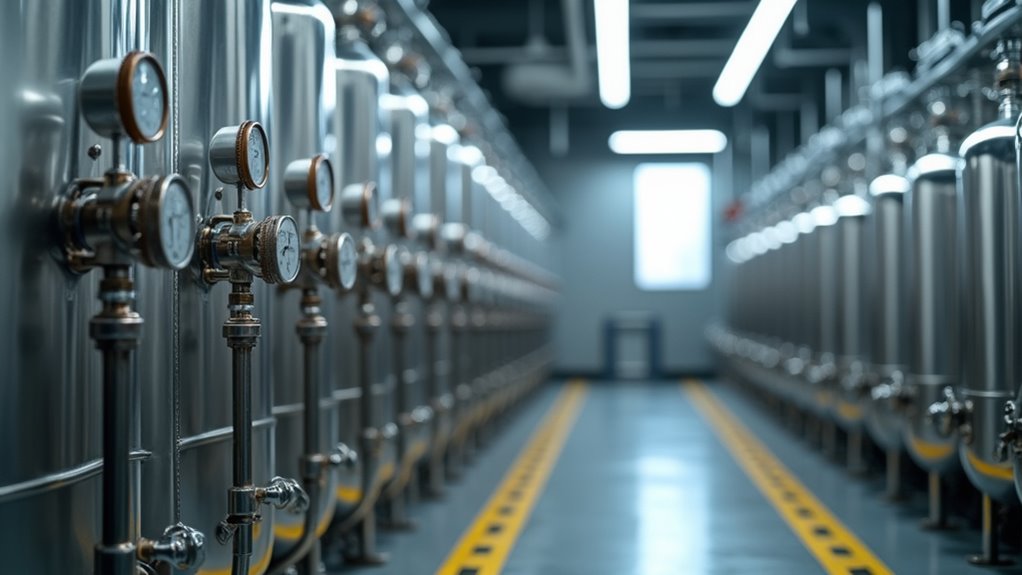Proper nitrous oxide storage requires strict adherence to NFPA 99 ventilation standards and fire-rated containment systems. You’ll need non-reactive materials, temperature controls, and continuous monitoring equipment to maintain gas integrity. Guarantee your facility implements backup power, upright cylinder storage, and clear labeling protocols. Document all maintenance, conduct regular compliance audits, and train personnel on proper handling procedures. Understanding these core requirements sets the foundation for an inclusive storage system design.
Essential Storage Requirements for Nitrous Oxide Systems

Proper storage of nitrous oxide demands strict adherence to regulatory requirements and safety protocols. You’ll need to guarantee your storage facility meets NFPA 99’s ventilation requirements through low-wall intakes and ceiling exhausts to prevent dangerous gas accumulation. Install backup power systems to maintain critical safety controls during outages. Store nitrous oxide cylinders upright to ensure optimal safety and stability. Carefully segregate full and empty cylinders using a proper labeling system per storage requirements without central supply.
Your storage room must feature 1-hour fire-rated walls and ¾-hour rated doors to contain potential fires. For enhanced safety, automatic sprinkler systems must be installed throughout the storage area. Don’t install compressors in central supply areas, as this violates code requirements. Maintain proper airflow with two ventilation openings one near the floor and one at the ceiling. Regular inspections should verify that fire barriers remain intact, ventilation systems function properly, and emergency power systems activate when needed.
Keep storage areas secure and monitor for compliance with all regulatory standards.
Material Selection and Safety Standards

The selection of appropriate materials for nitrous oxide storage systems requires strict adherence to safety standards and compatibility requirements. You’ll need to confirm storage containers are constructed from non-reactive steel or aluminum alloys with rust-resistant coatings to prevent chemical interactions. When designing your storage facility layout, incorporate non-flammable construction materials and maintain separation from incompatible chemicals. Medical gas cylinders containing nitrous oxide can be comingled with non-flammable gases like carbon dioxide, medical air, and helium in the same storage room. Proper age verification procedures must be implemented before allowing access to storage areas.
Your storage system must include temperature-resistant components to handle potential liquid nitrogen freezing effects and pressure fluctuations. Install cross-ventilation systems and corrosion-resistant piping to prevent gas accumulation and material degradation. Remember to follow NFPA 99 guidelines for medical gas systems, including proper cylinder labeling and emergency protocols. Always verify that storage racks are reinforced and rated for cylinder weights, typically ranging from 50-200 pounds.
Environmental Control Measures

Building on material safety requirements, extensive environmental control measures demand rigorous monitoring and emission reduction protocols for nitrous oxide storage facilities. You’ll need to implement all-encompassing air quality monitoring systems, including gas detectors and multi-gas analyzers that track NOx concentrations in real-time. Installing a single portable unit allows for simultaneous measurement of N2O, CH4, CO2, and O2 levels across various facility locations.
Your facility must incorporate energy recovery strategies through integrated off-gas collection units and temperature-controlled storage systems. Install dedicated manifolds with vacuum capabilities and guarantee proper vent placement above roof level to minimize atmospheric release.
You’ll reduce emissions by maintaining sub-zero storage temperatures and using distillation systems to remove nitrogen impurities. Keep in mind that regulatory compliance requires documenting all control measures, particularly in regions with strict emission limitations. Implement preventive maintenance programs to identify potential leaks before they impact the environment.
Regulatory Compliance and Documentation
Maintaining detailed regulatory compliance for nitrous oxide storage requires adherence to five critical documentation protocols. You’ll need to implement extensive recordkeeping procedures that track purchase logs, maintenance records, and compliance audits while maintaining current supplier licenses and permits.
Your documentation must include up-to-date training documentation for all handlers and transporters, demonstrating their competency in managing nitrous oxide systems. You’re required to maintain detailed inventory tracking, including purchase quantities, recipient information, and storage capacity compliance. Following CGA G-8.3-2016 guidelines, organizations should establish comprehensive safe handling procedures even though the standard is not federally mandated.
Keep thorough maintenance records of cylinder inspections and system upgrades, ensuring they meet ASME and DOT specifications. In addition, you must properly document all ownership transfers and maintain standardized labeling protocols for containers and storage areas, adhering to jurisdiction-specific restrictions and quantity limits.
Storage Types and Distribution Methods
Modern nitrous oxide storage systems employ distinct configurations based on facility requirements and operational scale. You’ll find three primary system configurations that optimize space while meeting strict safety protocols:
- Centralized liquid storage systems utilizing bulk cryogenic tanks with fire-rated enclosures and specialized ventilation requirements
- High-pressure cylinder systems featuring H-cylinder manifolds in dedicated storage rooms with emergency power
- Portable E-cylinder racks designed for smaller facilities or backup redundancy
When selecting your storage configuration, you must consider ventilation requirements, fire safety standards, and emission control. Liquid systems, while space-efficient, face significant loss through venting and leakage. High-pressure systems offer better containment but require more storage space. Medical support gas storage requires proper nitrogen or instrument air systems for essential non-respiratory applications. Each configuration incorporates precise monitoring systems to maintain consistent gas delivery pressures.
All configurations demand proper separation from non-medical areas, contamination prevention measures, and specific ventilation design for gas dispersion.
Best Practices for System Maintenance
You’ll need to maintain strict regular inspection protocols for your nitrous oxide storage systems, including pressure checks, leak tests, and thorough equipment audits according to regulatory standards. Implementing state-of-the-art monitoring helps detect potential system failures before they occur.
Your safety equipment must undergo systematic verification of functionality, with particular attention to emergency shutoff valves, pressure relief devices, and monitoring systems. Storing nitrous oxide systems in well-ventilated areas is essential for preventing gas accumulation. All tanks must be kept in a cool, dry area to prevent potential damage and ensure optimal system performance.
To guarantee compliance and system integrity, you should document all inspections, maintenance activities, and equipment replacements in your facility’s safety records, following industry guidelines such as EIGA Doc 33 and ISO 23208.
Regular Inspection Protocols
Regular inspection protocols form the cornerstone of safe nitrous oxide storage management, as systematic evaluations help prevent catastrophic system failures and gas leaks. You’ll need to conduct daily surface contaminant assessments, focusing on nozzles, regulators, and valves for combustible residues. When implementing detergent selection criteria, choose only approved non-particulate cleaning agents to maintain system integrity.
Key inspection requirements include:
- Visual examination of protective caps and nuts on unused connections to verify moisture barrier integrity
- Documentation of all maintenance activities in detailed logs, including dates and repair actions
- Assessment of cylinder conditions for dents, cracks, or signs of corrosion before deployment
Remember to monitor ambient temperatures and maintain proper ventilation rates during inspections, ensuring storage areas remain below 25°C with adequate air exchanges for safety compliance.
Safety Equipment Upkeep
Proper safety equipment upkeep demands rigorous adherence to standardized maintenance protocols, focusing on critical system components and contamination control measures. You’ll need to verify cylinder orientation is upright and maintain cleanliness levels below 500 mg/m² for oils and organics.
Ensure material compatibility by using only non-combustible components for tubing and connectors. You should test pressure alarms monthly and implement real-time monitoring systems to detect flow anomalies.
Replace aged valves, hoses, and filters according to manufacturer schedules, and conduct annual professional audits of your pipeline systems.
Don’t forget to maintain leak detection systems and verify they’re properly calibrated. When changing gas service, thoroughly clean pressure receptacles and remove all visible particles, fibers, and water droplets using approved chemical cleaning agents for N₂O systems.
Emergency Protocols and Risk Management
While handling nitrous oxide demands constant vigilance, implementing detailed emergency protocols and risk management strategies is critical for facility safety. You’ll need to establish clear incident reporting procedures and maintain high staff hazard awareness through regular training and drills. Guarantee your team understands immediate response actions for leaks and spills. Proper ventilation systems must be installed to prevent dangerous gas inhalation risks.
Proper nitrous oxide management requires robust safety protocols, comprehensive staff training, and clear emergency response procedures to protect facility personnel.
Key emergency protocol components must include:
- Gas detection systems with automated alerts and containment procedures
- Documented evacuation routes and emergency contact information
- Spill management equipment with spark-proof tools and proper PPE
You’ll need to coordinate with local authorities for rapid response capabilities and maintain detailed records of all incidents. Regular updates to your emergency protocols should reflect evolving safety standards and lessons learned from previous incidents or drills.
Frequently Asked Questions
How Long Can Nitrous Oxide Be Stored Before It Needs Replacing?
Under proper storage conditions, your nitrous oxide can remain stable for 6-12 months in high-pressure cylinders. You’ll need to monitor several expiration date considerations, including the cylinder’s service life (up to 30 years) and gas stability.
You should maintain temperatures between 50°F-80°F and keep cylinders away from direct sunlight. If you notice any leaks, pressure drops, or visible damage, you’ll need to replace the gas immediately regardless of timeframe.
Can Nitrous Oxide Cylinders Be Transported in Standard Delivery Vehicles?
Yes, you can transport nitrous oxide cylinders in standard delivery vehicles when following specific vehicle loading procedures and regulatory requirements. You’ll need to guarantee proper securement to prevent movement and maintain appropriate transport temperature range.
However, you must comply with 49 CFR Subpart G and ADR regulations, including quantity limits (≤2 kg for individuals, ≤333 kg with reduced requirements). For commercial transport, you’ll need ADR certification and proper documentation including waybills.
What Happens if Nitrous Oxide Accidentally Freezes During Storage?
If your nitrous oxide freezes during storage, you’ll face several critical hazards. The freezing temperatures can damage cylinder valves and compromise system integrity, while subsequent thawing may cause unpredictable pressure buildup.
You’ll need to immediately isolate affected cylinders and monitor for leaks. Don’t attempt to rapidly warm frozen cylinders, as this can create dangerous pressure spikes. Contact your gas supplier for proper handling procedures and potential equipment inspection.
How Often Should Staff Undergo Refresher Training for Handling Procedures?
You’ll need to complete mandatory refresher training at least every 3 years per OSHA and EPA regulations. However, you should participate in monthly staff evaluations to assess your competency and determine if more frequent training is required.
Annual safety audits may also identify areas necessitating additional instruction. Your employer must document all training sessions and guarantee you’re up-to-date with current protocols, especially after technical changes or procedural updates.
Are There Specific Insurance Requirements for Facilities Storing Nitrous Oxide?
You’ll need extensive insurance coverage that aligns with regulatory restrictions and storage volume limitations. At minimum, secure property damage, general liability, and environmental liability policies.
Your coverage must specifically address nitrous oxide risks and meet NFPA 99 requirements. If your facility exceeds 3,000 cubic feet of storage, you’ll require increased insurance limits.
Don’t forget to include system failure coverage and maintain workers’ compensation for employees handling the gas.







